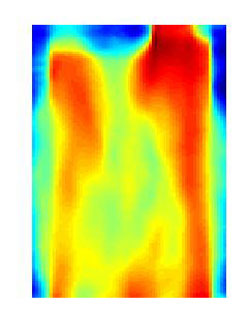Off the Wall

When the sun-baked ground heats adjacent air, the hot air rises and the cooler air sinks, in a chaotic flow called turbulent convection. Although similar flows affect everything from computer chips to air conditioning, researchers haven’t managed to measure how the heat flow behaves far from the heated surface. In the 3 March PRL, French researchers describe the first such experiments, using a sensitive arrangement of thermometers in a cell of heated water. The team also determined the size of the “blobs” of warm water that carry the heat and proposed a way to measure heat flow in less controlled situations, such as the atmosphere. The results could help researchers better understand convection high in the atmosphere and inside of stars.
To study convection, experimenters usually confine a fluid such as water between two horizontal metal plates. As the lower plate’s temperature is raised, hot water rises and cold water sinks, first in orderly patterns, and then in a chaotic way, with random lumps of warm or cold water constantly rising and sinking. Most of the temperature change in such turbulent convection occurs in thin boundary layers near the upper and lower plates because the fluid motion mixes the rest of the water and nearly equalizes the temperature. The tiny temperature differences between points at different heights have been undetectable so far, so researchers haven’t been able to fully measure how heat flows through.
Mathieu Gibert and his colleagues at the Ecole Normale Supérieure in Lyon, France, managed to detect the small temperature differences in the middle of a convecting fluid, far from the boundaries. Using a water-filled convection cell, the team inserted two pairs of thermometers with identical characteristics at two different heights, in a so-called bridge arrangement that allowed detection of differences as small as a few thousandths of a degree. They carefully controlled the amount of heat flowing through the cell and measured the temperatures over a period of 24 hours. The relationship between temperature and heat flow is the basic property of a turbulent fluid that no one had measured before.
The researchers’ data matched the prediction of a forty-year old theory of convection that had never been verified in the lab. In the process, they used their measurements of the fluctuations in temperature over time to deduce a new and previously unmeasured property of turbulent convection: the typical size of the lumps, or “blobs,” of warm water that float up through the cell. The blobs were between 4 and 7 centimeters across under the conditions of their cell.
The team also established a direct relationship between the amount of heat transported through convection and the so-called Reynolds number, which describes the speed and turbulence of the roiling fluid. Reversing that relationship, they propose that in a real-world case like the atmosphere, researchers could simply measure the speed and temperature fluctuations in the fluid to find out how much heat is flowing through it. Currently there is no good way to measure the flow of heat in such situations because it flows in all directions and is uncontrolled.
Detlef Lohse of the University of Twente in The Netherlands says that experimenters have been trying to verify the theory for a long time, but no one was able to measure heat flow properties in the bulk fluid and exclude the boundary layers. This heat flow “has never been seen before experimentally,” says Guenter Ahlers of the University of California, Santa Barbara, and “it’s a beautiful piece of work.”
–Don Monroe
Don Monroe is a freelance science writer in Murray Hill, New Jersey.


